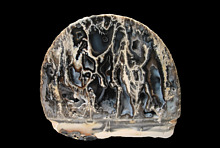Home PageAbout MindatThe Mindat ManualHistory of MindatCopyright StatusWho We AreContact UsAdvertise on Mindat
Donate to MindatCorporate SponsorshipSponsor a PageSponsored PagesMindat AdvertisersAdvertise on Mindat
Learning CenterWhat is a mineral?The most common minerals on earthInformation for EducatorsMindat ArticlesThe ElementsThe Rock H. Currier Digital LibraryGeologic Time
Minerals by PropertiesMinerals by ChemistryAdvanced Locality SearchRandom MineralRandom LocalitySearch by minIDLocalities Near MeSearch ArticlesSearch GlossaryMore Search Options
The Mindat ManualAdd a New PhotoRate PhotosLocality Edit ReportCoordinate Completion ReportAdd Glossary Item
Mining CompaniesStatisticsUsersMineral MuseumsClubs & OrganizationsMineral Shows & EventsThe Mindat DirectoryDevice SettingsThe Mineral Quiz
Photo SearchPhoto GalleriesSearch by ColorNew Photos TodayNew Photos YesterdayMembers' Photo GalleriesPast Photo of the Day GalleryPhotography
╳Discussions
💬 Home🔎 Search📅 LatestGroups
EducationOpen discussion area.Fakes & FraudsOpen discussion area.Field CollectingOpen discussion area.FossilsOpen discussion area.Gems and GemologyOpen discussion area.GeneralOpen discussion area.How to ContributeOpen discussion area.Identity HelpOpen discussion area.Improving Mindat.orgOpen discussion area.LocalitiesOpen discussion area.Lost and Stolen SpecimensOpen discussion area.MarketplaceOpen discussion area.MeteoritesOpen discussion area.Mindat ProductsOpen discussion area.Mineral ExchangesOpen discussion area.Mineral PhotographyOpen discussion area.Mineral ShowsOpen discussion area.Mineralogical ClassificationOpen discussion area.Mineralogy CourseOpen discussion area.MineralsOpen discussion area.Minerals and MuseumsOpen discussion area.PhotosOpen discussion area.Techniques for CollectorsOpen discussion area.The Rock H. Currier Digital LibraryOpen discussion area.UV MineralsOpen discussion area.Recent Images in Discussions
Mineralogical ClassificationIMA 2017-005 = hydrokenopyrochlore
17th Oct 2018 20:06 UTCMarco E. Ciriotti Manager
▪ Biagioni, C., Meisser, N., Nestola, F., Pasero, M., Bobyr, M., Roth, P., Schnyder, C., Gieré, R. (2018): Hydrokenopyrochlore, (□,#)2Nb2O6·H2O, a new species of the pyrochlore supergroup from the Sahatany Pegmatite Field, Antananarivo Province, Madagascar. European Journal of Mineralogy, 30, 869-876.
Abstract:
The new mineral species hydrokenopyrochlore, ideally A(□,#)2BNb2XO6·YH2O, has been discovered in the Antandrokomby pegmatite, Sahatany Pegmatite Field, Antananarivo Province, Madagascar. It occurs as tan to beige subhedral crystals, up to 1mm in size, with a resinous luster, associated with quartz, tourmaline, orthoclase, Li-bearing mica, hübnerite, stibiotantalite, and an undetermined heftetjernite-like mineral. Electron-microprobe analysis of hydrokenopyrochlore yielded (in wt%): WO3 8.14, Sb2O5 (tot) 14.33, Nb2O5 44.09, Ta2O5 13.97, SiO2 0.51, SnO2 0.21, CaO 0.86, MnO 0.04, Na2O 1.79, Cs2O 14.47, H2Ocalc 2.23, total 100.64. On the basis of 2 B-site cations per formula unit and by recalculating the Sb2O3:Sb2O5 ratio in agreement with structural data, the chemical formula of hydrokenopyrochlore is (□1.32Sb3+0.35Na0.26Ca0.07)Σ2Nb1.47Ta0.28 W0.16Sb5+0.05Si0.04)Σ2.00O6[(H2O)0.55 Cs0.45]. The main diffraction lines, corresponding to multiple hkl indices, are [d in Å (visually estimated relative intensity) hkl]: 3.136 (s) 311, 3.006 (s) 222, 2.598 (w) 400, 2.010 (ms) 333/511, 1.846 (s) 440, 1.588 (ms) 622, and 1.509 (m) 444. The crystal structure study returned a cubic unit cell, space group Fd3m, with a = 10.4887(8)Å, V = 1153.9(3)Å3, Z = 8. The crystal structure has been solved and refined to R1 = 0.056 on the basis of 105 unique reflections with Fo>4σ(Fo) and 14 refined parameters. The crystal structure is formed by a framework of BO6 octahedra, as is typical of the members of the pyrochlore supergroup. The B site has a mixed (Nb, Ta, W) occupancy. The A site is mainly vacant, whereas the Y site is occupied by both H2O groups and Cs. The high Cs content of hydrokenopyrochlore seems to be indicative of the central miarolitic and most evolved portions of the pegmatitic dikes in the Sahatany Pegmatite Field.




Mindat.org is an outreach project of the Hudson Institute of Mineralogy, a 501(c)(3) not-for-profit organization.
Copyright © mindat.org and the Hudson Institute of Mineralogy 1993-2024, except where stated. Most political location boundaries are © OpenStreetMap contributors. Mindat.org relies on the contributions of thousands of members and supporters. Founded in 2000 by Jolyon Ralph.
Privacy Policy - Terms & Conditions - Contact Us / DMCA issues - Report a bug/vulnerability Current server date and time: April 25, 2024 04:37:06
Copyright © mindat.org and the Hudson Institute of Mineralogy 1993-2024, except where stated. Most political location boundaries are © OpenStreetMap contributors. Mindat.org relies on the contributions of thousands of members and supporters. Founded in 2000 by Jolyon Ralph.
Privacy Policy - Terms & Conditions - Contact Us / DMCA issues - Report a bug/vulnerability Current server date and time: April 25, 2024 04:37:06










